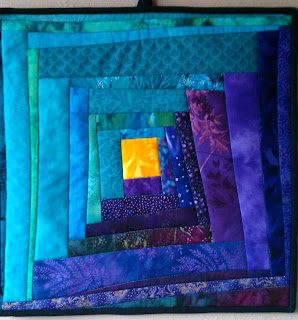#4: Crazy
Finished: 1/29/12
Techniques: Victorian Style Crazy Patchwork, Embossing on Velvet
Size: 16x17"
Description:
While researching Victorian Era Crazy Quilts I learned that nearly any types of fabric and embellishments were used. For my Crazy mini-quilt, I used wools, velvets, corduroys, brocades, satins, and woven fabrics along with various pieces of lace and trim, including fringe on the bottom of the piece. I also read about how to emboss onto velvet using a rubber stamp, and I incorporated three embossings, a sun, a snowflake, and a star, which can be seen in the photo. By laying the velvet face down on top of a rubber stamp, apply a hot iron to the back of the fabric for 30 seconds. I feared that the heat from the iron might damage the stamp, but they all survived just fine.
I also used many decorative stitches on the sewing machine in a variety of embroidery thread colors to add some embellishment.
I did not use any batting on this mini-quilt. Because of the weight of the fabrics, it didn't seem to need it. I "quilted" the piece with a bar tack stitch on each of the individual pieces in a matching color to the fabric. It was like "tying" the quilt, but without the yarn.
This was a fun quilt to do, but working with heavy fabrics was a work-out. I don't know that I'd want to create a full-sized Victorian crazy quilt.




